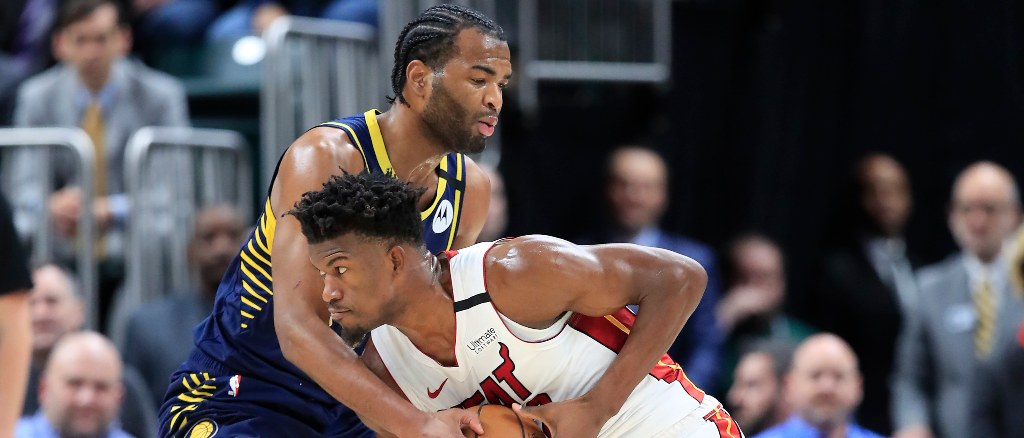
The Indiana Pacers and the Miami Heat will square off in the 4-5 series in the Eastern Conference, and for those who enjoy watching basketball teams who seem to relish the opportunity to get into brawls, this series is a godsend. Miami and Indiana are two tough, nasty squads, and even if they go about scoring points in different ways, both take pride in their ability to defend and their commitment to never backing down. There’s also the whole Jimmy Butler-T.J. Warren thing, which seems like the sort of beef that could bubble over in a playoff series.
The series between these two squads tips off on Tuesday afternoon, with Game 1 beginning at 4 p.m. EST on TNT. Before that begins, though, we identified a pair of areas — one for each team — that should determine which team is able to come out on top.
Indiana Pacers: Will they be able to make twos?
One thing that Indiana really loves to do is take a whole lot of twos. No team in the league has made more twos than Indiana, only two teams (the Spurs, coached by someone who hate threes, and the Knicks, a team of power forwards) have attempted more, and while they’re 11th in two-point field goal percentage (52.9 percent), the sheer volume they’ve taken means that no team has scored more points via twos than Nate McMillan’s bunch.
The issues with this are twofold. One is that Domantas Sabonis is out, and he is capable of just cooking dudes from inside the three-point line. Sabonis attempted 12.6 twos for the team per game and connected on 56.5 percent of them — the only other players who attempt at least 12 twos a game and connect on at least 56 percent of them this season are the two MVP favorites (Giannis Antetokounmpo, LeBron James), the Sixth Man of the Year favorite (Montrezl Harrell), and Zion Williamson.
The other issue is that Miami does not let teams take twos. Funny enough, they mirror the Pacers pretty nicely: Third in the league in two-pointers allowed and first in two-pointers attempted on defense. Despite being 15th in two-point field goal percentage allowed, they give up so few attempts that only Toronto and Milwaukee have allowed opposing teams to score fewer points from inside the arc.
Indiana’s offense banks on taking and making twos. No team attempts fewer threes, and it will be interesting to see if McMillan switches things up and tells his guys to let it fly if Miami’s interior defense puts the clamps on them. It will be a legitimate war inside the arc, though, and the Pacers really need to make sure they win it.
Miami Heat: Can they continue to crack the Pacers’ three-point defense?
Teams don’t hit a whole lot of threes against the Pacers. On the year, teams are connecting on 34.1 percent of their triples against the squad from Nap Town, the fourth-lowest mark in the entire league. There aren’t many teams in the league that take more pride in what they can do on the defensive end of the floor than Indiana, and over the course of the entire season, they’ve been absolute hell to score against — they’re sixth in the NBA in defensive rating, with the only squads ahead of them being the ones that you normally think of when you talk about the league’s elite defensive unites.
Their opponents in the first round, however, are one of the team’s elite three-point shooting units. Miami loves to let it fly and is outstanding at hitting from deep, coming in ninth in the league in three-point attempts and second in three-point field goal percentage at 37.9 percent. Their best player, Jimmy Butler, has shot the ball terribly from deep, but unlike his previous situation in Philly, the Heat have realized this isn’t a huge deal as long as you surround him with marksmen. As a result, the team has four players in their rotation who connect on at least 40 percent of their threes and a collection of extremely capable shooters beyond them.
Miami built a team where there are so many options to get hot that someone is inevitably going to have a good shooting game most of the time. Indiana is quite good at not allowing that to happen, although in the three games that they played against Miami this year outside of their seeding game finale in the Bubble, the Heat connected on 38.7 percent of their triples, with Duncan Robinson (14-for-31, 45.2 percent) especially getting hot from deep. Unsurprisingly, Miami went 3-0 in those games.
The Heat are the favorites to win this series, in large part due to their ability to get scorching hot (no pun intended) from deep. Indiana will do everything it can to take that way. If Miami’s shots fall, that will not matter.
